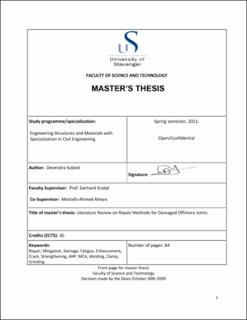Literature Review on Repair methods for Damaged Offshore Joints
Master thesis
Permanent lenke
https://hdl.handle.net/11250/2786238Utgivelsesdato
2021Metadata
Vis full innførselSamlinger
Sammendrag
Offshore structures subject to severe environmental loading may exhibit fatigue damage over time. In particular, fatigue cracks are a significant concern in welded components. Previous work has been published regarding the mitigation measures for many types of damage in steel structures. In addition, codes and standards, as for example, ISO, NORSOK, API, DNV, suggest suitable methods for mitigation and fatigue life improvement of welded components. Repair methods such as dry welding, structural clamps, remedial grinding, stop-hole drilling, and member removal can permanently or temporarily resolve the joint's fatigue damage. Mitigation methods like weld improvement techniques and grout filling can enhance the fatigue life of joints. The selection of repair methods is challenging as many parameters can influence the mitigation performance, such as crack size, location, and local detail geometry. Particularly, the repair method is different if the repair is to be performed in the atmospheric zone, splash zone, or in the submerged zone.The thesis aims to study different repair methods for fatigue damage in welded components and compare in terms of applicability, time off work, cost, fatigue life gain, and work deployment process. Analytic hierarchy process and Multi-criteria dimensional analysis are used to study the influence of selection criteria while choosing the suitable mitigation method. Case studies are performed based on the assumption of the crack size and location to select suitable mitigation measures. The conclusions are drawn regarding the selection criteria and work execution process.
